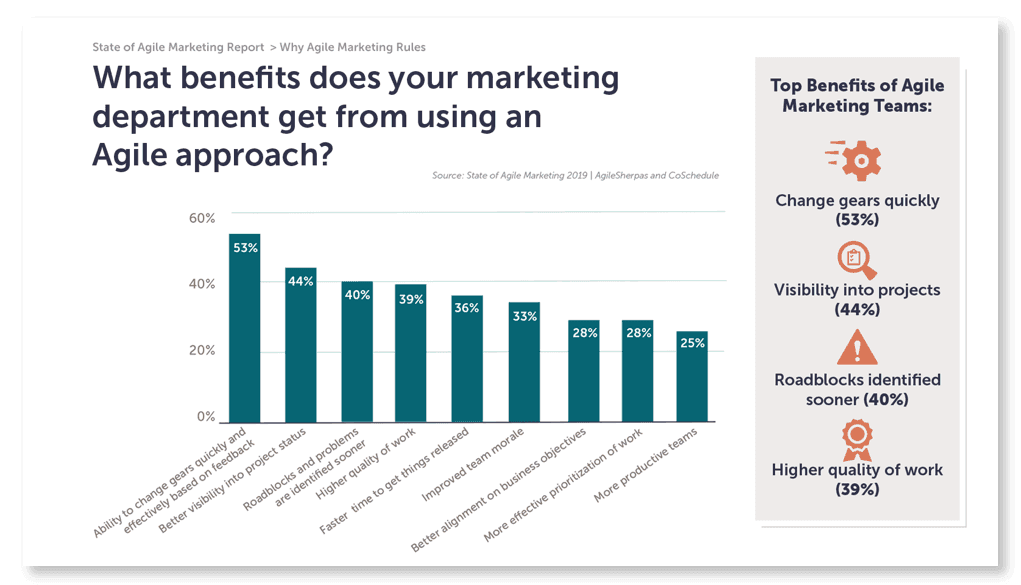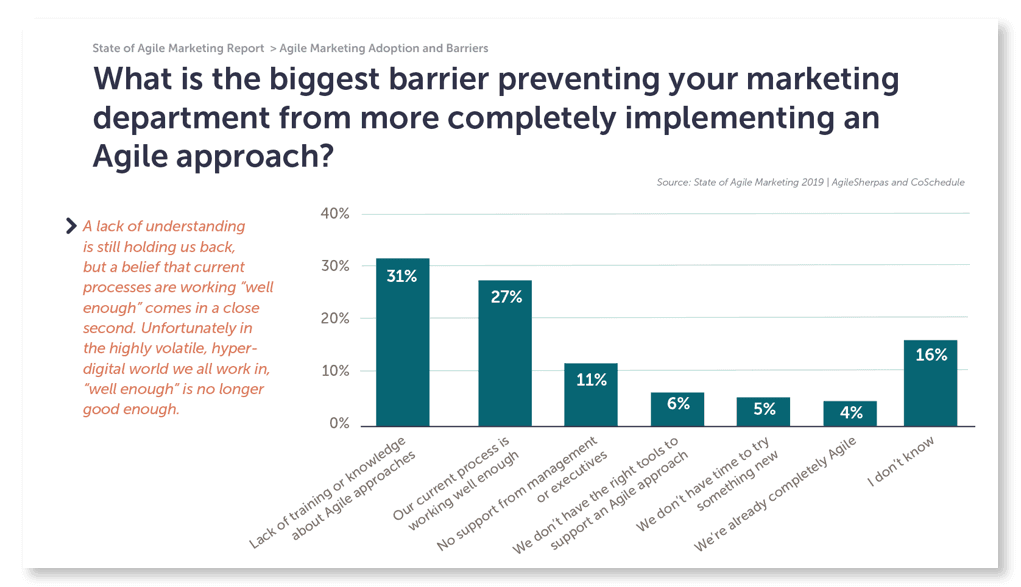How to Overcome 3 Main Hurdles to Agile Marketing (With Real-Life Stories)
 According to the 2019 State of Agile Marketing Report, teams who use Agile frameworks to manage their marketing operations enjoy a veritable parade of benefits:
According to the 2019 State of Agile Marketing Report, teams who use Agile frameworks to manage their marketing operations enjoy a veritable parade of benefits:
- They produce higher quality work (which, as you no doubt know, is the best/only way to create engagement with an audience).
- Their team members enjoy higher morale (employees at one organization felt 20% more valued as an employee after Agile marketing rolled out).
- Roadblocks surface sooner (practices like daily standup ensure that impediments don’t fester unnoticed for more than a day or two).
- Work gets out more quickly (one team went from a two-month campaign release cycle down to two weeks).
 But all of those spiffy numbers beg the question, if Agile marketing is so great, why isn’t everybody using it?
But all of those spiffy numbers beg the question, if Agile marketing is so great, why isn’t everybody using it?
Download the 2019 State of Agile Marketing Report
Ready to start implementing some Agile marketing practices, but need some cold hard facts to back up your transition? Download the State of Agile Marketing Report. It’s packed with great statistics and facts about why you should opt for an Agile methodology in your marketing.Hurdles to Agile Marketing Adoption
With adoption hovering around one-third of marketing teams, it’s time to explore — and clear — the three most commonly report hurdles standing between marketers and Agile marketing awesomeness. Research tells us there are three big rocks we need to move:- A lack of training or knowledge about Agile approaches.
- A belief that current processes are working well enough.
- Limited support from management and executives.

Agile Marketing Hurdle #1: Lack of Training or Knowledge
Given that just 32% of marketers currently report using an Agile process of some kind, it’s not surprising that knowledge isn’t thick on the ground. In fact, this has been the most commonly cited hurdle for the past two years we’ve done this study. It dropped 7% since last year, however. The good news on this front is that as Agile marketing moves rapidly from buzzword to business imperative, educational opportunities are exploding to help bridge this gap.Recommended Reading:
How to Get Started With Agile Marketing and Do Your Best Work
Live Options for Agile Marketing Training
In the past year, multi-day workshops open to the public have become increasingly available. Attendees at accredited trainings also become certified professionals in Agile marketing through the internationally certifying body ICAgile (International Consortium for Agile), making these trainings well worth the time and effort. If you’re considering whether to seek out these specialized offerings or opt for the ubiquitous CSM (Certified Scrum Master) course, I strongly recommend the former. Transitioning to Agile from traditional ways of approaching work can be a tough mental leap; you don’t want to extend the distance by adding the need to translate what you’re learning from software to marketing. Additionally, “pure” Scrum is rarely the long term modus operandi for marketers; we’re much more likely to end up using a hybrid Agile framework. That means limiting your early Agile education to Scrum may stunt your Agile growth and set you up to make otherwise avoidable mistakes. So whenever possible, seek out training in Agile marketing.
That means limiting your early Agile education to Scrum may stunt your Agile growth and set you up to make otherwise avoidable mistakes. So whenever possible, seek out training in Agile marketing.
Agile Marketing Training at Your Own Pace
If in-person training isn’t on your radar yet, there are still tons of educational options available. AgileSherpas offers an 80-minute virtual training (code coschedagile will get you a discount) that will give you a firm foundation to build from. There are also TONS of great written resources, some of which you can find without ever leaving this domain:- CoSchedule Guide to Agile Marketing
- AgileSherpas free resources
- 3-Step Getting Started Guide (subscription required)
- Step-by-step guide from McKinsey
Recommended Reading:
19 of the Best Project Management Training Opportunities for Marketers
One Real-Life Story of Agile Marketing Education
My company AgileSherpas has trained nearly 1,000 people on Agile marketing in various formats over the years, but no educational error stands out as strongly in that list as one of our first formal coaching gigs. (Identifying details have been changed to protect the innocent.) One January, a CMO showed up at the annual marketing planning meeting and declared the 40-person department would be going Agile that year. She then dropped the mic and left the room, providing no guidance or formal training path for her marketers. They struggled mightily for six months, reading as much as they could, cobbling together kanban boards, and (sort of) holding daily standup meetings. Sadly (and unsurprisingly), it wasn’t working. Their planning hadn’t changed. Their team structures hadn’t changed. The absence of documented strategic direction hadn’t changed. And yet somehow their operations were expected to change. By the time we showed up, there was so much frustration about the Agile process that there was very little remaining appetite for adjustment or improvement. Needless to say, this group didn’t enjoy all the Agile marketing benefits we listed earlier on. They didn’t even get a modest efficiency improvement. They were hamstrung by their lack of commitment to education from the start. Don’t follow in their footsteps.Agile Marketing Hurdle #2: Current Process Working Well Enough
This is one of those age-old battles: the status quo versus the unknown future. Sure, things might not be terrible right now, but there are so many reasons not to settle for “good enough.”
First and foremost, think about what inside your operations is slowing you down or holding you back.
Too many handoffs and approvals? Massive bottlenecks during execution? Nobody knows what marketing is doing or when? Everything just taking WAY longer than it should?
An Agile operations overhaul holds the key to all these problems (and more).
The greatest thing about fixing your process is that everything that flows through the optimized process goes better.
Sure, things might not be terrible right now, but there are so many reasons not to settle for “good enough.”
First and foremost, think about what inside your operations is slowing you down or holding you back.
Too many handoffs and approvals? Massive bottlenecks during execution? Nobody knows what marketing is doing or when? Everything just taking WAY longer than it should?
An Agile operations overhaul holds the key to all these problems (and more).
The greatest thing about fixing your process is that everything that flows through the optimized process goes better.
 It’s also important to consider that this year’s research revealed that 50% of traditional marketing teams are planning to adopt Agile marketing within the next year, so you can either get going ASAP or spend the next ten years playing catch up.
Remember those clever folks over at Red Bull who embraced content marketing early on and now get constantly cited as best in class?
Early adopters of Agile marketing are looking at similarly massive ROI.
Just think about it: if you currently do annual planning for your marketing, you get one opportunity each year to inspect and adapt.
If you do quarterly planning, you’re metabolizing change four times as fast.
But if you adopt the Agile practice of rapid iteration (also known as Sprints), you have the opportunity to respond to incoming data every couple of weeks.
At the standard pace of two-week Sprints, that increases your marketing metabolism 543%.
Well enough suddenly isn’t looking all that great, is it?
It’s also important to consider that this year’s research revealed that 50% of traditional marketing teams are planning to adopt Agile marketing within the next year, so you can either get going ASAP or spend the next ten years playing catch up.
Remember those clever folks over at Red Bull who embraced content marketing early on and now get constantly cited as best in class?
Early adopters of Agile marketing are looking at similarly massive ROI.
Just think about it: if you currently do annual planning for your marketing, you get one opportunity each year to inspect and adapt.
If you do quarterly planning, you’re metabolizing change four times as fast.
But if you adopt the Agile practice of rapid iteration (also known as Sprints), you have the opportunity to respond to incoming data every couple of weeks.
At the standard pace of two-week Sprints, that increases your marketing metabolism 543%.
Well enough suddenly isn’t looking all that great, is it?
Real-Life Story: Agile Marketing’s Pace Increase
The first time I ever experimented with using Agile in a marketing context I was running content marketing at a mid-sized SaaS company whose Agile development team released a lot. Like several times a day a lot. Our marketing team was trying to plan quarterly, but then we’d get thrown a curve ball when our hyper-Agile dev team would finish a new feature weeks ahead of schedule (because… Agile). After talking my writers down from a ledge for the tenth time, I realized we needed to move at a pace much closer to the team whose outputs we were marketing. In other words, marketing needed to be more Agile. I undertook a major round of self-education and convinced the team to give it a try. A few months later we were releasing experiments on a bi-weekly basis, my beloved content team was putting out more content than ever, and marketing had gone from last-minute afterthought to consulted partner in release discussions. A little education (and a little agility) goes a long way. [Tweet “Overcome real-life agile marketing hurdles with these 3 inspiring stories.”]Agile Marketing Hurdle #3: No Support from Leaders
Managers, executives, and directors tend to get a bad wrap when it comes to organizational evolution. And they are an easy scapegoat to use when change feels impossible and/or scary. But compared to our first two hurdles, leadership falls pretty low on the list of things keeping marketers from being more Agile. Just 11% of marketers said they struggle with this, compared to 27% who think the status quo is okay and 31% who need more education. Nonetheless, leaders are on the list and need attention. As we saw from our first IRL story, mismanagement at the executive level can short circuit change before it even gets going. So what’s an innovative marketer to do? First and foremost, be a good marketer. Focus on what’s in it for them. Sure, Agile helps us be less stressed and more productive, but why would an exec care about that?
Focus instead on their biggest pain point. What are they evaluated on, and how can you show Agile’s potential impact on that bottom line?
Consider case studies like the one from CA Technologies. Their SVP was able to show a 3x increase in marketing-sourced opportunities following an Agile implementation.
Or maybe their problem is more connected to hiring great people, and you should focus the conversation on how much more satisfied, engaged, and loyal employees tend to be on Agile teams.
If productivity is their big driver, take a look at these three Agile marketing metrics and consider running some projections on what your department might look like from this perspective.
If all of that feels overwhelming (because math), you can just start with this list of case studies and the great litany of Agile marketing benefits. No sums required.
Sure, Agile helps us be less stressed and more productive, but why would an exec care about that?
Focus instead on their biggest pain point. What are they evaluated on, and how can you show Agile’s potential impact on that bottom line?
Consider case studies like the one from CA Technologies. Their SVP was able to show a 3x increase in marketing-sourced opportunities following an Agile implementation.
Or maybe their problem is more connected to hiring great people, and you should focus the conversation on how much more satisfied, engaged, and loyal employees tend to be on Agile teams.
If productivity is their big driver, take a look at these three Agile marketing metrics and consider running some projections on what your department might look like from this perspective.
If all of that feels overwhelming (because math), you can just start with this list of case studies and the great litany of Agile marketing benefits. No sums required.
Recommended Reading:
How To Influence Marketing Change Management [Backed By Science]
Getting Executive Buy-In IRL
I just got back from my favorite example of making this happen in real life. A change agent inside a large (and I mean LARGE — like 2,000) marketing team wanted to get buy-in for major education effort. Her marketing leaders were preparing for a 3-day offsite meeting, and she managed to get Agile on the agenda. We helped facilitate the meeting and got a room full of VPs to agree that it was time to pilot Agile inside their various divisions. The power of face-to-face communication created a consensus that would have otherwise taken months (and maybe even years) to achieve. They also saw their peers get excited and commit to training and rollout plans, which will (hopefully) create some peer pressure as efforts continue.Hurdles Shmurdles. Make Agile Marketing Work for You
Yes, it can be difficult to fundamentally alter your process, but there are tools that can help your transition. For instance, CoSchedule is the only family of Agile marketing products to help you implement your new Agile strategy and deliver projects on-time. From planning to execution, CoSchedule gives you the ultimate visibility into your marketing strategy – never wonder again who is responsible for various marketing tasks, nor when each marketing campaign in launching. Everyone on your team knows their daily/weekly/monthly projects and can easily pivot based on shifting priorities, making Agile marketing easier than ever to implement. Remember, If change was easy everyone would do it and there wouldn’t be such a serious competitive advantage attached to getting it done. Whether your primary hurdle is education, the status quo, or getting your leaders to support you, there are always paths around (or over, or through, or whatever).


